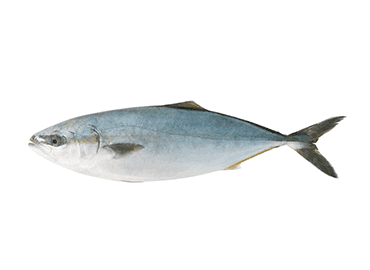Longfin Yellowtail

Species Details
Seriola Rivoliana
Carangidae
Carangiformes
Offshore
10 - 130 lbs.
35" - 60"
Longfin Yellowtail (Seriola rivoliana) Description
The Longfin Yellowtail, also known as the Almaco Jack, is notable for its dusky dorsal coloring, ranging from brown or silvery blue-green to olivaceous, and the amber strip on its side. Compared to other jack fish species, the Longfin Yellowtail has a more flattened and less elongated body.
The dorsal and anal fins of the Longfin Yellowtail are elongated with their outer edges sickle-shaped. The first rays of the dorsal fin on the Longfin Yellowtail are longer than its dorsal spines, while with other jack species, the reverse can be said.
The Greater Amberjack is similar in appearance to the Longfin Yellowtail. The best way to distinguish them is to look at the second dorsal fin. Compared side by side, the second dorsal fin on the Longfin Yellowtail is much higher.
Size & Diet
Most commonly found Longfin Yellowtail can measure up to 35 inches in length, with weight from 10 to 20 pounds. The fish can grow up to 60 inches and 130 pounds. The Longfin Yellowtail is carnivorous. It feeds day and night and is a fast-moving predator. It prefers to feed on bony fishes, particularly baitfish and invertebrates such as squid and shrimp.
Interesting Facts about Longfin Yellowtail
- The Longfin Yellowtail is reported to spawn throughout the entire year, going as often as every week.
- The flesh on this species can be mistaken for white albacore when prepared raw as it is dense and thick.
- The flesh on smaller Longfin Yellowtail is more desirable, as larger ones are prone to ciguatera. That's why most anglers practice catch and release for big Longfin Yellowtail.
- The Longfin Yellowtail is best served raw, but can also taste delectable when grilled or baked in foil with vegetables. Cooks do not recommend frying it as it tends to trap oil. It is best consumed within 3 days of its catch, though it keeps well frozen and vacuum-packed.
- The Longfin Yellowtail is prone to skin-based parasites, which it gets rid of by brushing against sharks. Scuba divers also report Longfin Yellowtail brushing against them, after being mistaken for sharks.
Fishing Technique: How to Catch Longfin Yellowtail
The Longfin Yellowtail is a favorite game fish among sport fishers as it is a fast and strong species that will put up a fight. It is not shy at all and may even approach anglers. Fishing for the Longfin Yellowtail does not require special gear, but anglers will need to make sure that their gear are up to scratch for this strong game fish.
Anglers can use encircling or dead nets, with bottom lines or floating lines, trolling with live bait, jigging or lure when fishing for the Longfin Yellowtail. Usually, a typical rent rod with Penn Jigmaster 500 will work fine on this game fish.
Anglers can use any of these fishing methods to target the Longfin Yellowtail: drift fishing, jigging, chumming, bottom bouncing, and still fishing. For baits and lures, anglers will find success with squid, shrimp, spoons, jigs, and plugs.
If you’re using the yo-yo technique when deep water fishing, use lures and jigs that match the color of the bait or the water you’re fishing in. Brands such as Sumo, Tady, and Salas are great sources.
Habitat and Distribution
The Longfin Yellowtail is a benthopelagic species. This fish occurs globally, both in temperate and tropical waters. It schools with small groups and can be found in open ocean zones beyond the continental shelf. It also prefers structures such as wrecks. It can generally found swimming in waters with depths of 16 to 524 feet.
This fish species can occur in the waters of the Indian Ocean to the West Pacific Ocean. Populations of the Longfin Yellowtail are found in South Africa, Mariana Islands, Wake Island, Ryukyu Islands, Kermadec Islands, and New Caledonia. It is also reported to occur in the eastern Pacific, ranging from California to Peru and the Galapagos Islands. In the western Atlantic, this fish can also be found from Cape Cod to Argentina, though not as common in South Carolina and North Carolina. It is rarely found in the eastern side of the Atlantic, but it is reported to also live in Britain and off Lampedusa in the Mediterranean Sea.







